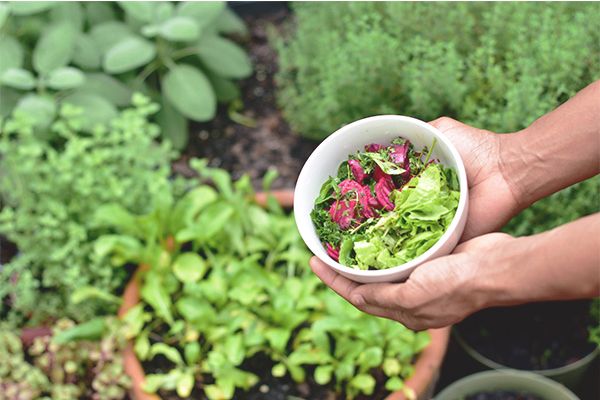Vegetable Gardening in Containers

Benefits of a Container Garden
Your dream is to reap bountiful harvests of fresh, homegrown, nutritious fruits and vegetables. An admirable goal! but what if you're gardening space is limited or unsuitable for raising food? I highly recommend trying your hand at container gardening. It's an excellent solution to many gardening problems and not only does this solution work for vegetables, you can also grow fresh fruits and savory herbs, even edible flowers of any kind. A window sill, patio, balcony or doorstep will provide sufficient space for a productive mini-garden. Soil-borne diseases or poor soil conditions can be easily overcome by simply moving your garden from the ground into containers. Almost any vegetable or fruit that grows in the typical backyard garden will do well as a container-grown plant. Vegetables ideally suited for growing in container gardens include tomatoes, peppers, eggplants, green onions, beans, lettuce, squashes, radishes, parsley, and a whole host of others. Pole beans and cucumbers also do well, although, they require considerably more space and a support structure because of their vining growth habit.
Which Containers to Use
Almost any type of container can be used for growing vegetables. The size of the container should vary according to the plant you select and space available. Pots from 6"-10” in size are satisfactory for green onions, lettuce, parsley, and other herbs. For most vegetable crops such as tomatoes, peppers, eggplants, you'll need a container about the size of a 5-gallon bucket. This is still fairly easy to handle and provides adequate space for root growth.
A more recent invention that has made container gardening so much easier is the EarthBox. This is a self contained system that really maximizes plant growth and yield but takes a minimum amount of space. An added feature is the self-watering reservoir that allows you to go a week (sometimes longer) without watering.
Regardless which type or size of container used, adequate drainage is a necessity for successful yields. It is advisable to add about 1” of coarse gravel in the bottom of the container to improve drainage. The drain holes are best located along the side of the container, about ¼” to ½” from the bottom.
Seeding and Transplanting
Best suited for container culture are vegetables which may be easily transplanted. Most vegetables should be transplanted into containers when they develop their first two to three true leaves. Transplanting should be done carefully to avoid injury to the young root system.
Fertilization
We recommend using Bumper Crop Tomato & Vegetable Food or Espoma Garden Tone to fertilize vegetables. (The EarthBox system utilizes an organic plant food that is only applied at the beginning of the growing season).
Watering
Proper watering is essential for a successful container garden. Generally one watering per day is adequate. However, poor drainage will slowly kill the plants. The mix will become water-logged and plants will die from lack of oxygen. If at all possible, avoid wetting the foliage of plants since wet leaves will encourage plant diseases.
Environmental Light
Nearly all vegetable plants will grow better in full sunlight than in shade. However, leafy crops such as lettuce, cabbage, greens, spinach and parsley can tolerate more shade than root crops such as radishes, beets, turnips and onions. The root vegetables can stand more shade than those which bear fruit, such as cucumbers, peppers, tomatoes and eggplant. One advantage to container gardening is mobility. Container gardening makes it possible to position the vegetables in areas where they can receive the best possible growing conditions.
Pests & Diseases
Vegetables grown in containers can be attacked by the various types of insects and diseases that are common to any vegetable garden. Plants should be periodically inspected for the presence of foliage and fruit-feeding insects as well as the occurrence of diseases. Should problems occur, then the timely application of EPA-approved fungicides and insecticides is advised. Many natural organic choices are now available.
Harvest
For the greatest amount of enjoyment from a container garden, harvest the vegetables at their peak of maturity when a vegetable’s full flavor has developed. This will yield maximum pleasure from the excellent taste of vine-ripened tomatoes, tender green beans and crisp flavorful lettuce.
